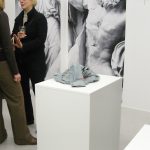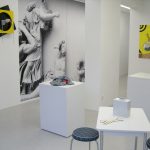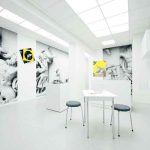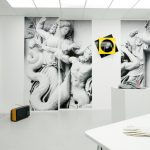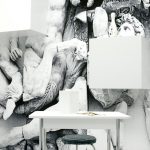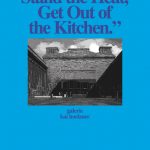If You Can’t Stand the Heat, Get Out of the Kitchen
coated hardboard, different objects, print of the wall frieze of the Pergamon altar, painting, 2009
a room installation for the group exhibition „If You Can´t Stand the Heat, Get out Of The Kitchen“ with artists from the gallery Kai Hölzner
with: Andreas Gehlen, Stephan Gripp, Phillip Maiwald, Uwe Schinn
„Having been silent for a longer while Heilmann said that works such as those originating in Pergamon have to be continuously re-interpreted until reversal is achieved and the mortals awake from darkness and slavery showing their true appearances.”
One of the more interesting turns of recent history manifested itself when those classes passing in previous decades as “the proletariat” gained control over culture if not over discourses.
Different from what Peter Weiss describes in his book „Aestethics of Resistance“ not the persis-tence required to attend evening classes at the adult education centre in order to pile up Kafka, Greek, playing the guitar or Guernica, paved the way to the heights of contemporary cultures, but rather the ahistoric adoption and reapplication of images and so called positions.
Such the participation of the mortals in the culture production-process is no longer based on their rebellion against somebody else constantly making political and cultural decisions for them, but rather on the pleasure principle which is largely foreign to Peter Weiss’ book. The struggle for culture and education did not serve as those hammers and chisels instrumental to forge a self-determined social sculpture, but the body and celebrity culture. They turned out to be the more effective and above all available means to wrestle culture from the hands of ‘those in power’.
The exhibition „If you can’t stand the heat, get out of the kitchen“ transfers the Giants Frieze from the Pergamon-Museum to the gallery at the Kottbusser Tor. The frieze stretched like a wall-paper across the wall adopts the strategy of using trans-historic, imitating images. White-coated kitchen-cabinets assembled from furniture-boards recharge the decontextualized ma-terial with new myths, the corresponding subtexts of which originate from Hans Coppi’s 1937 kitchen in the Rosenthaler Strasse and all the way back to the square stone blocks of the hill of Pergamon, the heads and members of which were knocked off over the centuries to serve as home building materials. Where elements of the frieze are missing, the incomplete is filled by personal images and reliefs.
Galeie Kai Hölzner
